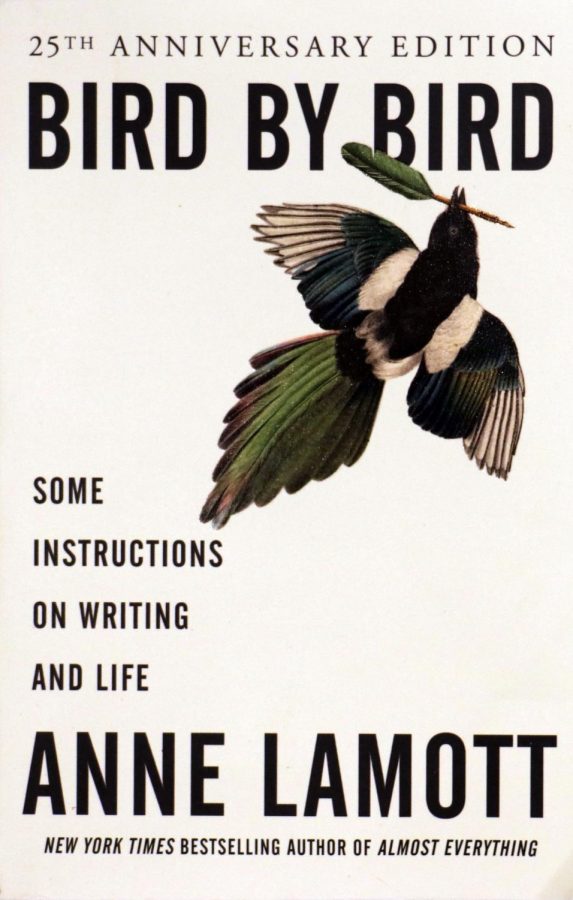Taking flight: Discovering a candid, transformative message in “Bird by Bird”
How should aspiring writers aim to approach the task—and lifestyle—of writing?
Claire Luo
“Bird by Bird: Some Instructions on Writing and Life” is a 274 page novel by Anne Lamott that was first published on May 5, 1994. Lamott is also the author of “Operating Instructions: A Journal of My Son’s First Year,” “Traveling Mercies” and “Almost Everything: Notes on Hope.”
March 26, 2021
Arya’s ranking: ★★★★☆
Weaving witty dialogue together with honest reflection, “Bird by Bird: Some Instructions to Writing and Life” surveys the realities of writing and its extensions to broader life through instructive chapters in Lamott’s quintessentially wry and down-to-earth style.
The book was recommended to me by my 11th grade English teacher, Ms. Miller, who suggested it as a guide to not only sharpen my writing but also read about incredible stories from a writer who has been there, done that. It certainly lived up to—if not exceeded—that task.
Don’t be fooled by the subtitle: “Bird by Bird” is about as far from a dry, didactic text as it gets. Most pedagogical books I’ve read claim to hold novel, brilliant, exciting, out-of-this-world ideas—and while they may contain important information, they end up wrapped up in the same pedantic, condescending tone that seems unavoidable when an expert delivers wisdom on us laity.
Lamott doesn’t do that. While any reader should be warned of high levels of sarcasm and acerbic commentary featured in “Bird by Bird,” it is precisely that unfiltered inner monologue that holds the antidote to humdrum (or worse, haughty) instructive writing.
Lamott begins by briefly describing her background and journey into writing, before frontloading the two most important pieces of advice she claims she could give any writer. The middle section of the book examines a variety of the specific elements involved in developing a story, featuring ideas on topics ranging from finding a plot that fits to letting your characters grow in the most natural, if unexpected, way.
As she surveys the vast variety of obstacles that budding writers will surely face, Lamott powerfully verbalizes the often-amorphous anxieties and challenges that pass through most people’s minds—writers and otherwise—through relatable storytelling and reflection before providing equally resonant methods of solving the problems.
“You get your confidence and intuition back by trusting yourself, by being militantly on your own side. You need to trust yourself, especially on a first draft, where amid the anxiety and self-doubt, there should be a real sense of your imagination and your memories walking and woolgathering, tramping the hills, romping all over the place. Trust them. Don’t look at your feet to see if you are doing it right. Just dance. You get your intuition back when you make space for it, when you stop the chattering of the rational mind. The rational mind doesn’t nourish you. You assume that it gives you the truth, because the rational mind is the golden calf that this culture worships, but this is not true. Rationality squeezes out much that is rich and juicy and fascinating” (138).
Clever expressions that articulate the emotional rollercoaster of creative work comprise some of “Bird by Bird’s” most memorable passages. This passage comes from a section where Lamott discusses the importance of following your inner instinct, the voice in your head that guides you to what you truly want to say.
After outlining the lack of productivity and ensuing consequences that often result from placing too much faith in logic and reason as means to an end, Lamott presents her take on eschewing rationality and trusting your intuition in breaking writing barriers.
Since its publishing in 1994, “Bird by Bird” has been heralded as a must-read for aspiring writers, complementing bare-bones writing manuals like Strunk and White’s classic with its more narrative style, which mixes do’s and don’ts with memoir-based reflection.
But much of the unique wisdom that “Bird by Bird” contains lies in chapters that discuss the emotions and experiences tangential to writing, rather than concrete elements of a story itself. From quieting the judgemental voices in one’s head to learning how to deal with the jealousy of successful peers, Lamott articulates the takeaways from her experiences by writing as if in a raw, heart-to-heart conversation with the reader, packaging her thoughts into concise, memorable pieces of advice.
Lamott’s lessons comprise a valuable resource to anyone in need of a guide whether in the writing world or beyond, keeping the reader engaged throughout the 274-page tour of wit and wisdom that is “Bird by Bird.”
I would certainly recommend “Bird by Bird” to anyone looking for lessons on writing from a human perspective—and especially to anyone struggling with mental obstacles and anxieties in the process, which, as Lamott powerfully conveys, are challenges that most writers have to face every day.
Those who appreciate sarcasm and snarky remarks would especially enjoy the novel’s often-quotable prose, though others might find Lamott’s tone slightly jarring or uncomfortably brazen at times. Overall, however, the authenticity of Lamott’s message and her generally down-to-earth storytelling sets “Bird by Bird” apart from other instructional texts on writing.
For those who enjoy “Bird by Bird,” Arya recommends “On Writing Well” by William Zinsser, “Writing Down the Bones” by Natalie Goldberg and “On Writing: A Memoir of the Craft” by Stephen King.




![LALC Vice President of External Affairs Raeanne Li (11) explains the International Phonetic Alphabet to attendees. "We decided to have more fun topics this year instead of just talking about the same things every year so our older members can also [enjoy],” Raeanne said.](https://harkeraquila.com/wp-content/uploads/2025/10/DSC_4627-1200x795.jpg)


















![“[Building nerf blasters] became this outlet of creativity for me that hasn't been matched by anything else. The process [of] making a build complete to your desire is such a painstakingly difficult process, but I've had to learn from [the skills needed from] soldering to proper painting. There's so many different options for everything, if you think about it, it exists. The best part is [that] if it doesn't exist, you can build it yourself," Ishaan Parate said.](https://harkeraquila.com/wp-content/uploads/2022/08/DSC_8149-900x604.jpg)




![“When I came into high school, I was ready to be a follower. But DECA was a game changer for me. It helped me overcome my fear of public speaking, and it's played such a major role in who I've become today. To be able to successfully lead a chapter of 150 students, an officer team and be one of the upperclassmen I once really admired is something I'm [really] proud of,” Anvitha Tummala ('21) said.](https://harkeraquila.com/wp-content/uploads/2021/07/Screen-Shot-2021-07-25-at-9.50.05-AM-900x594.png)







![“I think getting up in the morning and having a sense of purpose [is exciting]. I think without a certain amount of drive, life is kind of obsolete and mundane, and I think having that every single day is what makes each day unique and kind of makes life exciting,” Neymika Jain (12) said.](https://harkeraquila.com/wp-content/uploads/2017/06/Screen-Shot-2017-06-03-at-4.54.16-PM.png)








![“My slogan is ‘slow feet, don’t eat, and I’m hungry.’ You need to run fast to get where you are–you aren't going to get those championships if you aren't fast,” Angel Cervantes (12) said. “I want to do well in school on my tests and in track and win championships for my team. I live by that, [and] I can do that anywhere: in the classroom or on the field.”](https://harkeraquila.com/wp-content/uploads/2018/06/DSC5146-900x601.jpg)
![“[Volleyball has] taught me how to fall correctly, and another thing it taught is that you don’t have to be the best at something to be good at it. If you just hit the ball in a smart way, then it still scores points and you’re good at it. You could be a background player and still make a much bigger impact on the team than you would think,” Anya Gert (’20) said.](https://harkeraquila.com/wp-content/uploads/2020/06/AnnaGert_JinTuan_HoHPhotoEdited-600x900.jpeg)

![“I'm not nearly there yet, but [my confidence has] definitely been getting better since I was pretty shy and timid coming into Harker my freshman year. I know that there's a lot of people that are really confident in what they do, and I really admire them. Everyone's so driven and that has really pushed me to kind of try to find my own place in high school and be more confident,” Alyssa Huang (’20) said.](https://harkeraquila.com/wp-content/uploads/2020/06/AlyssaHuang_EmilyChen_HoHPhoto-900x749.jpeg)











